The Fist 2022 Cross-cultural Awareness WorkshopJourney of “Hayabusa” and Lessons Learned
Speaker: Dr. MATOKAWA Yasunori, Honorary Professor of Japan Aerospace Exploration Agency
Date: June 19,2022
Venue: International House of Japan
Co-sponsor: Minato City Board of Education
At the beginning, Mr. NAGANO Hiroshi, Advisor of MUA, gave an opening address and introduced today’s speaker. Dr. MATOKAWA Yasunori is the last disciple of Dr. ITOKAWA Hideo, the father of Japanese space development, and was played by Mr. NISHIDA Toshiyuki in the movie with the theme of “Hayabusa”.
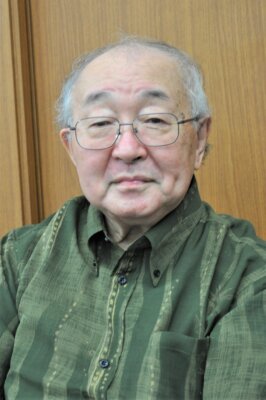
What inspired researchers to explore asteroids?
In 1985, researchers gathered in Uchinoura, Kagoshima Prefecture, to explore Halley’s Comet. Uchinoura is the rocket launching base, where INO Tadataka once was forced to give up the survey from the land because of its extreme remoteness back in the Edo Era. Since there was nothing there, what they could do were only to have glasses of liquor and enjoy talking each other. The researchers in the science department said that there were 400,000 asteroids at that time in the solar system between Mars and Jupiter and that if we examine it, we may find old things left there. Although they are interested in analyzing what were brought to them, they have no interest in going out and taking them. Conversely, we engineering department are not interested in analysis, but we like building devices to launch rockets and take samples. Both engineers got excited and the talk of “a sample return plan from an asteroid” was brought up overnight. If an asteroid hit the earth, the human race will become extinct. The study of asteroids was important in this aspect as well.
Various Challenges
We submitted the “Hayabusa Project” to the Space Development Commission, but the plan was deemed as the sheer madness and was not dealt with as there were eight world firsts in the plan. However, the “reckless” project was eventually approved, as it was considered meaningful to implement it in a gloomy society with the burst of bubble economy.
There exist many challenges. Even if you instruct to “dodge”, there is a 40-minute time lag in operation at a distance of 300 million kilometers. This leads to creating a system in which Hayabusa thinks and acts on its own. Then “not enough money”. Only a quarter of the budget was allocated. Thus, as we could not rely on large companies, we visited on our own foot each and every small factory in an effort to find out the one which could offer the cheapest cost to cooperate with us. One example is the development of the target marker to lead “Hayabusa” to the exact landing point. Even if it is dropped, it needs to settle on Itokawa, which has low gravity, without bouncing. When we were having an argument in confusion at a bar, someone who was drinking next to us heard this and brought a beanbag from home. The grain of beanbag will collide inside and the excess energy will be lost. He was craftsman at a nearby small factory, and was the person who developed the target marker.
When it was only four months before returning home, all four engines stopped. Even the indomitable project manager whined for the first time. However, of the four ion engines, one out of two negative poles was alive while the other one out of two positive poles was alive. They were not connected by design…however, they actually, were secretly connected behind the scene. It was against the rule, but it did help.
Success of Hayabusa 1
The capsule landed in Australia on June 13, 2010 and was recovered. The capsule is heat resistant, but the body was not, so it broke apart and disappeared in the atmosphere. It was sad to see it. 1600 grain samples were collected.
When I was asked in the NHK TV program what the reason was for our success in one word, I answered “moderately poor.” It’s easy to depend on a large company, but it costs money. As we did not have enough money, we physically visited the factory and observed the site. Thus, we came up with more and more ideas to overcome troubles without consulting with a company. In restrospect, we should have said that if you have high aspirations for the future, you can get through even in poverty.
Hayabusa 2
The budget for Hayabusa 2 was completely cut in its entirety. However, politicians saw the “popularity of Hayabusa” and supported it. As a result, the budget was fortunately reinstated. Hayabusa 2 headed for Ryugu on December 3, 2014. Unlike Asteroid Itokawa, the target of Hayabusa 1, Ryugu, was full of rocks and, therefore, a landing point could not be found easily as there was no level ground of about 100㎡ (where we were confident of landing). While we were quite anxious if Hayabusa 2 could land in a narrow place, we decided to carry out the touchdown on the ground of about 6㎡ as we performed computer simulation of 100,000 landings in all success. So, on February 22, 2019, the first touchdown was carried out and objects that flew up were collected.
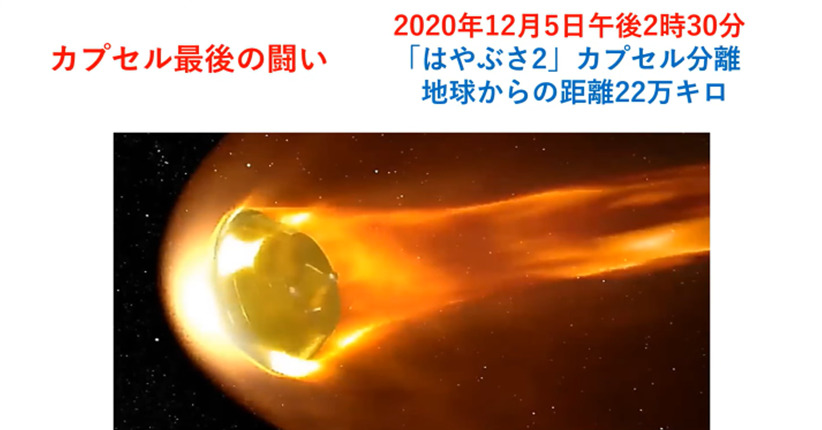
There was an opinion that Hayabusa 2 should return home after one trip, but on April 5, we created an artificial crater with a bomb. As the inside has not changed much compared to the surface, there existed real old substances there. While investigating the crater, Hayabusa 2 stopped falling and rose again on its own. However, we found the suitable place and let it touch down again on July 11, and collected samples. On December 6, 2020, the capsule arrived at the targeted location in Australia, and the main body of Hayabusa 2 traveled on to another planet.
Samples taken from Ryugu
There were 5.4g of samples in the capsule. It seems like small amount, but for an analyst, it’s a huge amount. 40% of samples is kept in anticipation of the evolution of analysis technology in the future. Some of them were sent to research institutes around the world. After a year, results are beginning to appear. I heard on the phone last night that it turned out to contain 7% water. Though 7% seems like a small number, there are only 0.02% on Earth.
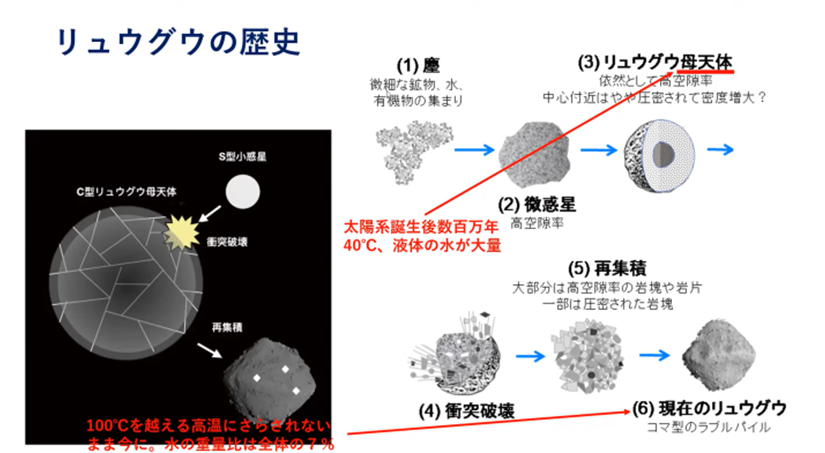
History of Ryugu
(1)Dust
Collection of minute minerals, water, and organic matter
(2)Planetesimals
High Porosity
(3)Ryugu Parent Meteorite Body
Still High Porosity; Slight consolidation near the center and increased density for several million
years after the birth of the solar system; lots of liquid water
(4)Destruction by Collision
(5)Re-accumulation
Mostly high porosity boulders and rock fragments; partly compacted rock mass
(6)Current Ryugu
Top-shaped rubble pile
Okayama University detected amino acids. Proteins are chains of amino acids. Protein is essential for life. Of the 23 amino acids detected in Ryugu samples, 10 were the type that makes protein. Although it has been detected from meteorites etc. so far, it has not been made clear whether it was mixed after falling on the Earth. Thus, this is the first time that amino acids from the space was found.
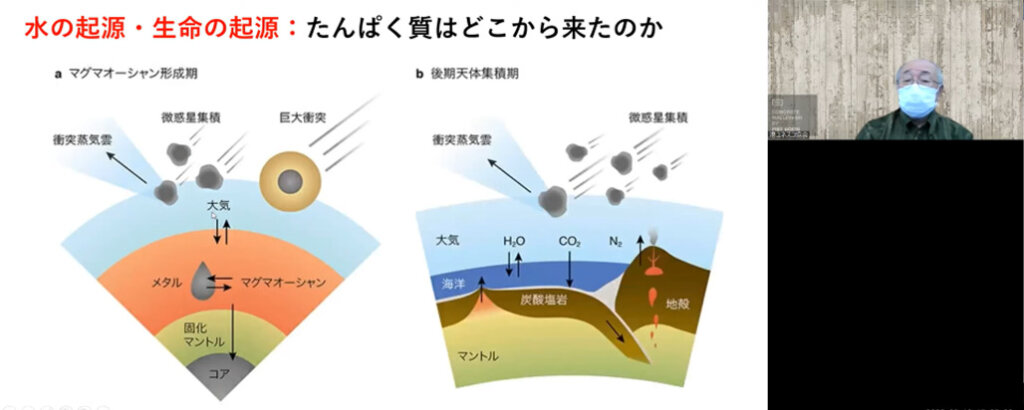
Future Space Research
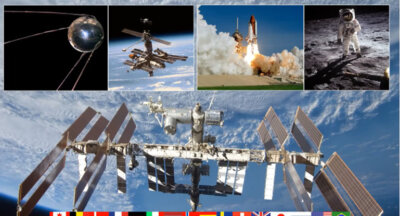
I saw the light of Sputnik when I was in junior high school in the City of Kure. It was the dawn of the space age. Then the competition between the USSR and the USA took place. However, after the collapse of the Soviet Union, 15 countries cooperated to set up the International Space Station. Japan also invests 40 billion yen annually. There exists an argument that this investment is too much, while there exist another opinion that it is small considering the maintenance of the position of Japan in the world.
The Apollo program was the peak of the first phase of the space research. Phase 2 of the program is still in progress. Japan enjoys the highest success rate of artificial satellites. We also have the world’s best weather satellite. I believe we can go to space in the very near future. I also believe that the history of the universe will be revealed as well. Anything is possible in the universe. All phenomena are cosmic.

Besides the risk of the extinction for mankind due to an asteroid collision, we surely face the bigger risk of being extinguished due to World War III induced by the absence of dialogue between different cultures and civilizations. This is clear if we simply observe the problems of environmental destruction, nuclear weapons, and situation in Ukraine. We need to take care of this Earth for years to come.
(Written by YAMADA Yuko, the International Science & Culture Committee, and translated by SUDA Yasushi, the PR & Internet Committee Associate)
